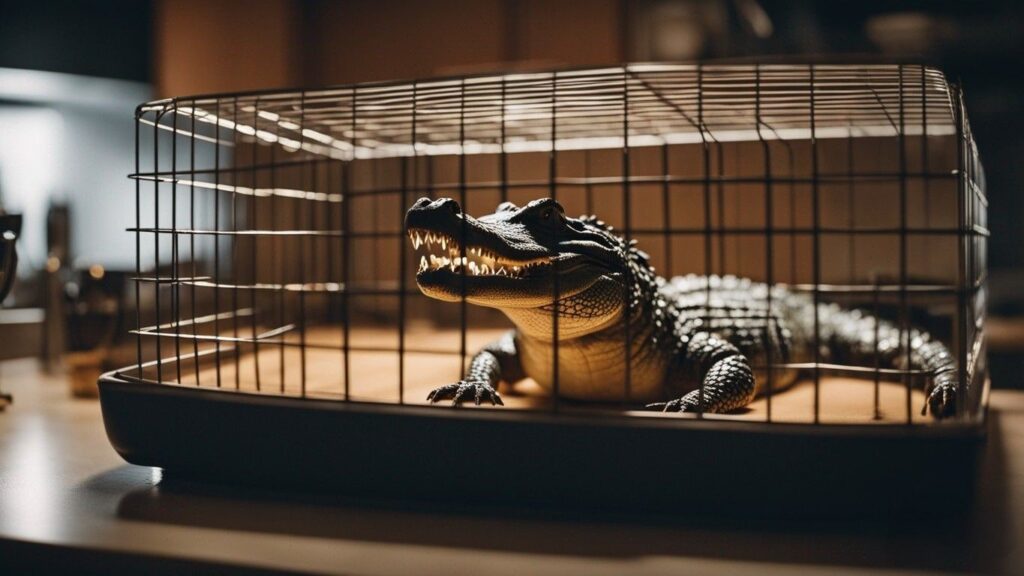
So, you’re thinking about getting lizards as pets, huh? Well, before you rush off to the pet store, it’s important to know which lizards can peacefully coexist in the same enclosure.
After all, you don’t want any scale-covered squabbles breaking out! In this article, we’ll explore the fascinating world of multilizard households, showcasing the different species that are known to get along well together.
From the friendly bearded dragon to the sociable blue-tongued skink, we’ll explore the possibilities and help you choose the perfect lizard companions for your reptile family.
Factors to Consider
When considering housing multiple lizards together, there are several important factors to consider.
These factors will ensure the well-being and compatibility of the lizards, providing them with a suitable and stress-free living environment.
The main factors to consider include the size of the lizards, their temperament, and their habitat requirements.
Size of the Lizards
The size of the lizards is crucial when determining whether they can cohabitate. It is generally recommended to house lizards of similar sizes together to avoid potential aggression or injuries caused by size discrepancies.
Large lizards may see smaller lizards as prey, while smaller lizards may feel intimidated or threatened by larger ones.
Therefore, it is best to pair lizards that are approximately the same size.
Temperament
Another crucial factor to consider is the temperament of the lizards. Some lizards are naturally more aggressive or dominant, while others are more docile and submissive.
Pairing lizards with similar temperaments can help minimize conflicts and ensure a peaceful living environment.
It is essential to research the temperament of each lizard species before attempting to house them together.
Habitat Requirements
Each lizard species has specific habitat requirements, including temperature, lighting, humidity, enclosure size, substrate, and decorations.
It is crucial to ensure that the habitat requirements of the lizards are compatible to avoid stress and health issues.
Different species may have different temperature and humidity needs, so it is essential to provide suitable conditions for all the lizards in the same enclosure.
Types of Pet Lizards that Can Cohabitate
Now that you have an understanding of the factors to consider when housing multiple lizards, let’s explore some types of pet lizards that are known to cohabitate successfully.
Remember to assess the compatibility based on the factors mentioned above, such as size, temperament, and habitat requirements.
Leopard Geckos
Leopard geckos are one of the most popular pet lizards and are known for their relatively calm and docile nature.
They generally cohabitate well with other leopard geckos of similar size and temperament, making them suitable for communal living arrangements.
Blue Tongue Skinks
Blue tongue skinks are known for their friendly and sociable nature. They can often be kept together in pairs or small groups, as long as there is ample space and hiding spots to avoid any potential territorial disputes.
Bearded Dragons
Bearded dragons are another popular choice for pet lizards. They are generally sociable and can be housed together, provided there is enough space and resources to accommodate them.However, it is important to monitor their behavior closely to ensure that there are no signs of aggression or dominance.
Green Anoles
Green anoles are relatively small lizards and can cohabitate peacefully, especially when housed in a larger enclosure with plenty of vertical space and hiding spots.
However, it is important to ensure that there are no significant differences in size between the anoles to prevent any potential clashes.
Crested Geckos
Crested geckos are known for their calm and solitary nature. While they generally prefer to be housed individually, some experienced reptile keepers have successfully housed compatible pairs or small groups of crested geckos together.
It is important to monitor their behavior closely and provide ample space and resources to ensure their well-being.
Tokay Geckos
Tokay geckos are known for their territorial and aggressive nature. It is generally not recommended to house them together, as they are more likely to display aggressive behaviors towards each other.
Tokay geckos are best kept individually in separate enclosures.
African Fat-Tailed Geckos
African fat-tailed geckos are generally docile and can be housed together, as long as their enclosure is spacious enough and has enough hiding spots for each gecko.
It is important to closely monitor their behavior to ensure compatibility and well-being.
Prehensile-Tailed Skinks (Monkey-Tailed Skinks)
Prehensile-tailed skinks are highly arboreal and require a large enclosure with ample climbing space.
While they are generally solitary creatures, compatible pairs or small groups can sometimes be housed together in a spacious, vertically-oriented enclosure.
Uromastyx
Uromastyx lizards are known for their herbivorous diet and solitary nature. They are generally best kept individually, as they can be territorial and show aggression towards each other.
Providing separate enclosures for each uromastyx is recommended.
Bolivian Racerunners
Bolivian racerunners are known for their active and semi-arboreal nature. They can cohabitate peacefully, as long as their enclosure is large enough and provides ample space for each lizard to establish its territory and retreat when needed.
Lizards that Should Not Be Housed Together
While there are several lizards that can cohabitate successfully, there are also certain species that should not be housed together due to potential conflicts and aggression.
It is crucial to avoid housing the following lizard species together:
Chameleons
Chameleons are solitary and territorial creatures that are best kept individually. Attempting to house multiple chameleons together can result in aggression and stress, leading to potential injuries or even death.
Iguanas
Iguanas are known for their territorial and aggressive behavior, especially during breeding season. Housing multiple iguanas together can lead to severe injuries, stress, and potential dominance battles.
Monitors
Monitors, such as the Nile monitor or the Savannah monitor, are large and highly active lizards that require a significant amount of space and resources.
Housing multiple monitors together can result in intense competition for territory and resources, leading to aggression and potential harm to the lizards involved.
Pairing Lizards of Similar Sizes
Pairing lizards of similar sizes is important for ensuring compatibility and minimizing potential conflicts. Let’s explore the compatibility of lizards based on their size categories.
Compatibility of Small-Sized Lizards
Small-sized lizards, such as anoles or leopard geckos, are generally compatible when housed together as long as their personalities and habitat requirements align.
However, it is crucial to ensure that there are no significant differences in size, as larger lizards may see smaller ones as potential prey.
Compatibility of Medium-Sized Lizards
Medium-sized lizards, such as blue tongue skinks or crested geckos, can often be housed together successfully if their temperaments and habitat requirements are compatible.
It is important to provide enough space and hiding spots to reduce potential conflicts.
Compatibility of Large-Sized Lizards
Large-sized lizards, such as iguanas or monitors, are generally not recommended to be housed with other lizards.
Their size and territorial nature can result in aggressive behavior and potential harm to smaller or less dominant lizards.
It is best to house large-sized lizards individually to ensure their well-being.
Matching Lizards with Similar Temperament
Matching lizards with similar temperaments can help establish a harmonious living environment. Let’s explore lizards based on their temperament categories.
Aggressive Lizard Species
Aggressive lizard species, such as tokay geckos or monitors, are best housed individually due to their territorial nature and aggressive behavior.
Attempting to pair them with other lizards, even if they are of similar size, can result in conflicts and potential harm.
Docile Lizard Species
Docile lizard species, such as leopard geckos or bearded dragons, are generally more suitable for cohabitation as they are less likely to display aggressive behaviors towards each other.
However, it is still important to closely monitor their behavior and provide sufficient space to prevent potential territorial disputes.
Coordinating Habitat Requirements
Coordinating the habitat requirements of multiple lizards is crucial to ensure their well-being and minimize stress. Let’s explore the main aspects to consider when housing multiple lizards together.
Lighting and Temperature Needs
Different lizard species have specific lighting and temperature requirements. It is important to provide each lizard with appropriate lighting and heat sources within the shared enclosure.
This may involve using separate heating elements or creating thermal gradients to accommodate the varying needs of different species.
Humidity Requirements
Humidity requirements can vary among lizard species. To ensure each species’ needs are met, it may be necessary to create microclimates within the enclosure or separate areas with specific humidity levels.
This can be achieved through the use of different substrates or misting systems.
Enclosure Size and Design
The enclosure size and design are crucial to provide sufficient space for each lizard to establish its territory and retreat when needed.
It is important to consider the adult size of the lizards and provide an enclosure that meets their space requirements.
Multiple hiding spots and climbing structures should also be provided to minimize potential conflicts.
Substrate and Decorations
Choosing suitable substrates and decorations are essential for both the physical and mental well-being of the lizards.
Some species may have different substrate preferences or require specific types of hiding spots or climbing structures.
It is important to research the requirements of each species and ensure their needs are met within the shared enclosure.

Proper Introductions and Quarantine
Properly introducing and quarantining lizards before housing them together is crucial to minimize stress, prevent the spread of diseases, and assess compatibility.
Let’s explore the necessary steps when introducing multiple lizards.
Observation and Monitoring
When introducing lizards, it is important to closely observe their behavior and interactions.
This can be done by providing a temporary divider in the enclosure or using separate enclosures adjacent to each other.
Monitoring their behavior over a period of time will help assess their compatibility and determine if they can be safely housed together.
Quarantine Period
Before introducing new lizards to an existing group, it is important to quarantine them for a minimum of 30 days.
This helps prevent the potential spread of parasites or diseases to the existing lizards. During the quarantine period, the new lizards should be kept in a separate enclosure and monitored closely for any signs of illness or health issues.
Signs of Incompatibility
Monitoring the lizards closely for signs of incompatibility is crucial to prevent potential harm or stress. Let’s explore some common signs that indicate the lizards may not be compatible.
Aggression or Dominance Displays
Aggressive behaviors, such as biting, chasing, or tail whipping, are clear indications of potential incompatibility.
Dominance displays, such as head bobbing or flaring of the dewlap, can also suggest territorial disputes and the need for intervention.
Lack of Food Consumption
If a lizard is consistently refusing to eat or showing a significant decrease in appetite, it could be a sign of stress or aggression from other lizards in the same enclosure.
It is crucial to address the issue promptly to ensure the well-being of all the lizards involved.
Physical Injuries
Physical injuries, such as bite marks or cuts, can occur in instances where lizards are incompatible or engaging in aggressive behavior towards each other.
It is important to closely inspect the lizards regularly to identify any injuries and address the situation accordingly.
Stress Behaviors
Lizards that are stressed may display behaviors such as excessive hiding, pacing, or excessive thrashing.
These behaviors can indicate that the lizards are not adapting well to their living environment and may need to be housed separately.
Best Practices for Keeping Multiple Lizards
To ensure the well-being and harmony of multiple lizards, it is important to follow some best practices. Let’s explore these practices in more detail.
Provide Sufficient Space
Ensuring that the enclosure provides sufficient space for each lizard is crucial. Overcrowding can lead to stress, aggression, and potential health issues.
It is important to provide enough hiding spots, climbing structures, and basking areas for each lizard to establish its territory and meet its needs.
Monitor Individual Health
Regularly monitoring the health of each lizard is essential to detect any signs of illness or injury.
This includes observing their behavior, appetite, and physical appearance. Any concerning changes should be addressed promptly, and veterinary care should be sought if necessary.
Individual Feeding Stations
Providing individual feeding stations for each lizard can help ensure that all lizards receive their required amount of food without competition or bullying.
Separate feeding stations also allow for monitoring individual eating habits and detecting any potential issues.
Proper Hygiene and Cleanliness
Maintaining proper hygiene and cleanliness within the enclosure is crucial to prevent the spread of diseases and parasites.
Regularly cleaning and sanitizing the enclosure, including substrates, decorations, and feeding dishes, helps create a healthy and hygienic living environment for the lizards.
Seeking Expert Advice
If you are unsure about housing multiple lizards together or need specific guidance, it is always best to seek expert advice.
Let’s explore some resources that can provide valuable insights.
Consult Reptile Veterinarians
Reptile veterinarians are highly knowledgeable about housing multiple lizards and can provide expert advice tailored to your specific situation.
They can assess the compatibility, health, and well-being of your lizards and guide you on proper housing practices.
Reptile Enthusiast Communities
Engaging in reptile enthusiast communities, both online and offline, can provide valuable insights and experiences from fellow lizard keepers.
These communities often have members with extensive knowledge and experience in successfully housing multiple lizards together.
Sharing your questions and concerns can help you gather different perspectives and recommendations.
Final Thoughts
In conclusion, housing multiple lizards together can be a rewarding experience when done correctly.
Considering factors such as size, temperament, and habitat requirements, selecting compatible lizard species, properly introducing and quarantining them, and following best practices will ensure the well-being and harmony of your pet lizards.
Remember to closely monitor their behavior and seek expert advice when needed to provide the best possible care for your reptilian companions.



